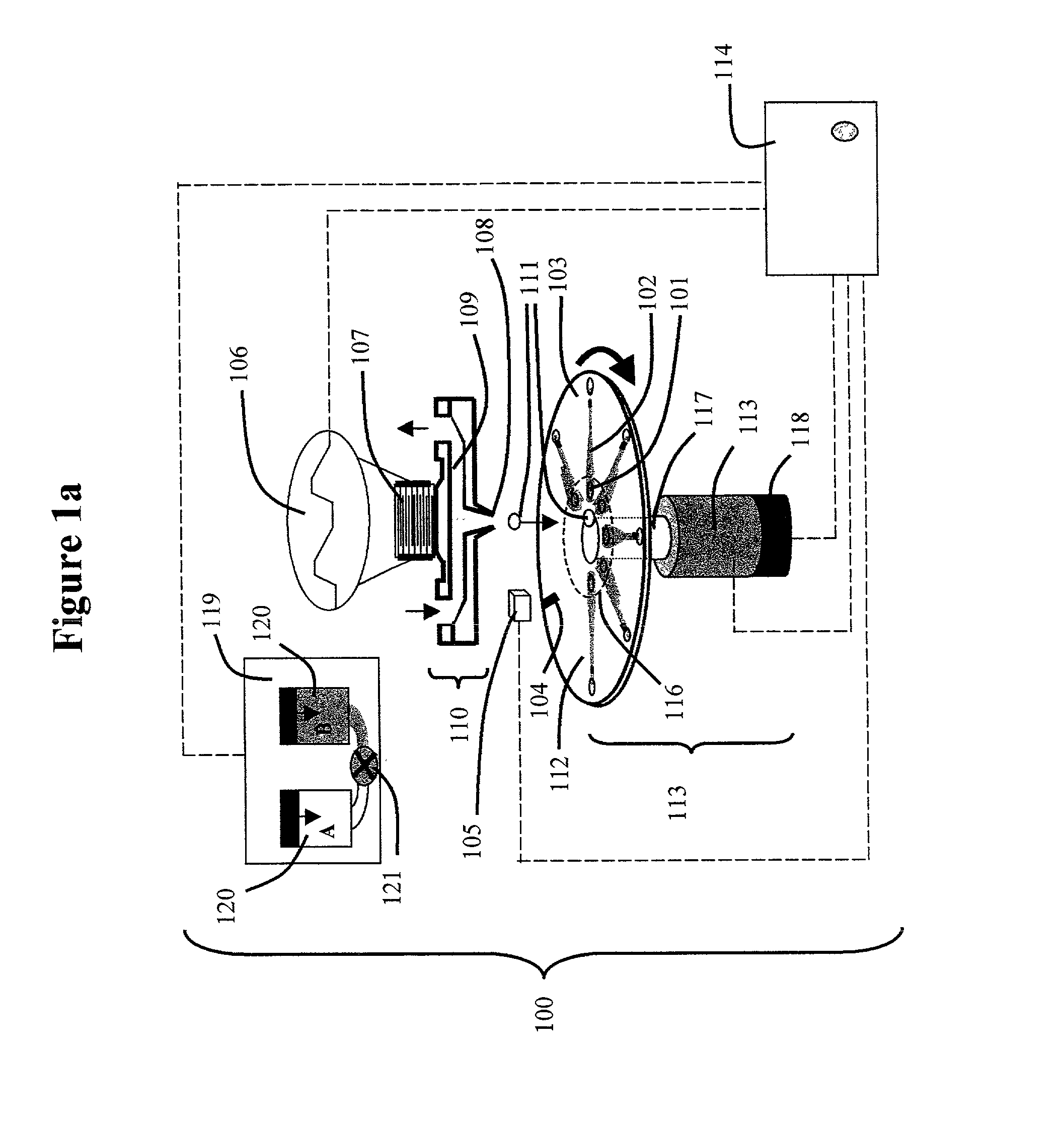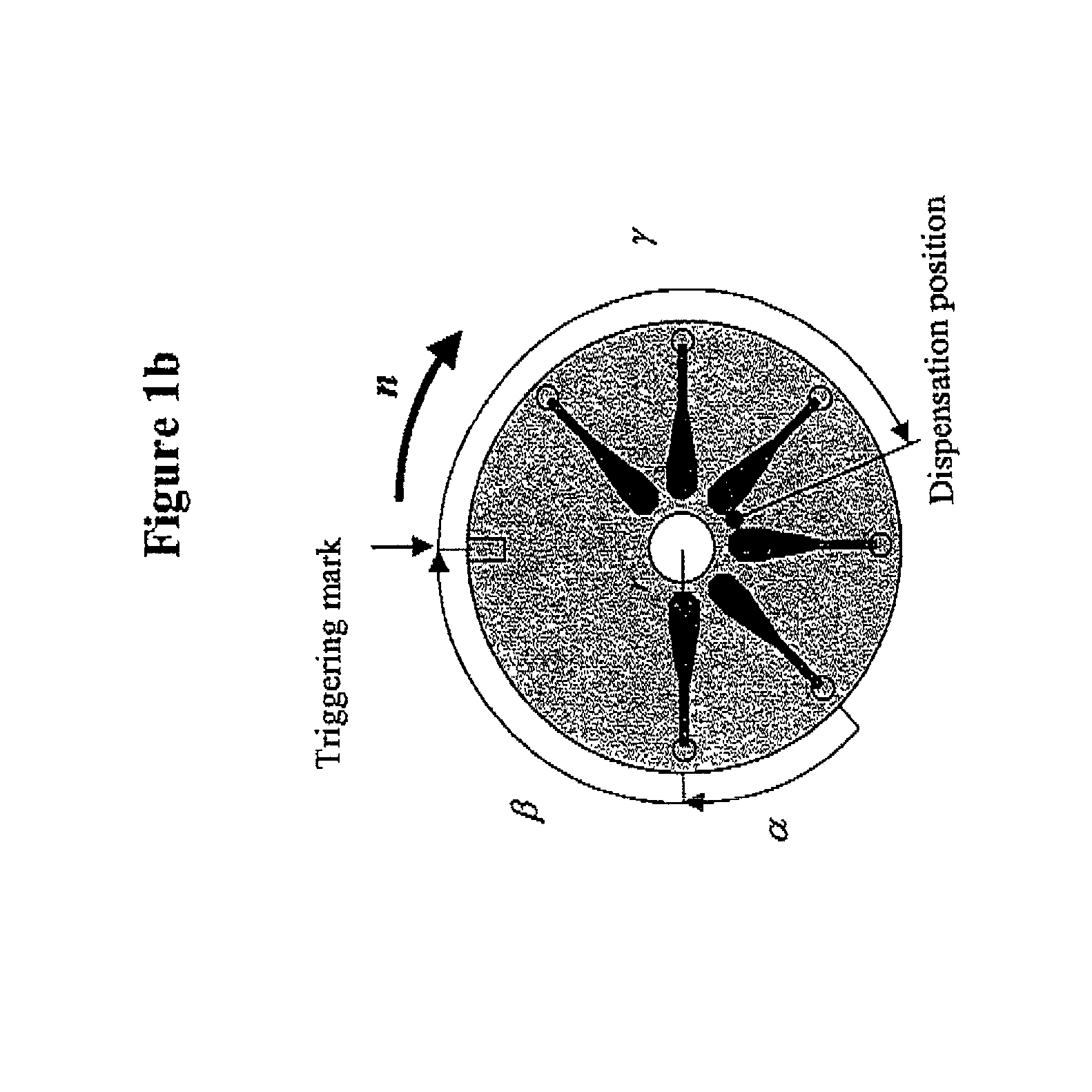Method and instrumentation for micro dispensation of droplets
a droplet and micro-dispensing technology, applied in the direction of mixers, component separation, decorative arts, etc., can solve the problems of micro-fabrication procedures, tedious dispensing procedures, unreachable interconnection, etc., and achieve the effect of easy mass production
- Summary
- Abstract
- Description
- Claims
- Application Information
AI Technical Summary
Benefits of technology
Problems solved by technology
Method used
Image
Examples
experiment 1
[0099] Investigation of the Flow Profile Deformation Occurring Between the Pump and the Dispenser
[0100] Experimental: The experimental set up was as in FIG. 1 except that the droplets were not collected in the microfluidic device. Colorimetry, with Cibacron dye (Brillant Red 4B-E, Ciba) in water was used to investigate gradients (from water up to 70% of the Cibacron solution applied over 1, 2 or 3 minutes) with different flow rates (0.1 and 0.5 ml / min). The process was monitored by collecting 500 droplets at predetermined intervals and measuring the colour intensity of the collected samples.
[0101] Results: FIG. 3 shows four gradients obtained from the dispenser. The result shown demonstrates the reproducibility of a 1 minute gradient at a flow rate of 0.3 ml / min. This graph shows that the gradient is obtained after 90 seconds indicating a lag time of 30s within the current configuration.
experiment 2
[0102] Velocity of the Droplet as a Function of the Gradient with a Constant Pulse
[0103] Experimental: The experimental set up was as in FIG. 1 except that the droplets were not collected in the microfluidic device. The variation in drop velocity v (m / s) with an acetonitrile gradient (0-80%) or a salt gradient 250 mM Tris-HCl pH 8 (0-1.5 M NaCl) was studied. The velocity was measured using a computer IR-camera system (Sydat Automation, Sweden) developed for evaluation of ink-jet print heads.
[0104] Results: Se FIG. 4. The physical properties of the dispensed liquid vary with the gradient profile and clearly affect the velocity of the droplets, leading to misalignment. However, this misalignment can be compensated for by adjusting various parameters, for example the trigger delay or the disc angular velocity (see equations 2 & 3) can be modified, although adjusting the angular velocity may affect flow control (see also FIG. 5).
[0105] For comparison when the disc is spun at 1500 rpm, ...
experiment 3
[0106] Velocity of the Groplet as a Function of the Pulse Amplitude
[0107] Experimental: The experimental set up was as in FIG. 1 except that the droplets were not collected in the microfluidic device. The drop velocity v (m / s) was studied as a function of the pulse amplitude for normal and high salt buffer solutions.
[0108] Results: By adjusting the pulse amplitude it is possible to adjust the drop velocity and thus to solve the misalignment problem.
PUM
| Property | Measurement | Unit |
|---|---|---|
| volume | aaaaa | aaaaa |
| volume | aaaaa | aaaaa |
| volume | aaaaa | aaaaa |
Abstract
Description
Claims
Application Information
 Login to View More
Login to View More - R&D
- Intellectual Property
- Life Sciences
- Materials
- Tech Scout
- Unparalleled Data Quality
- Higher Quality Content
- 60% Fewer Hallucinations
Browse by: Latest US Patents, China's latest patents, Technical Efficacy Thesaurus, Application Domain, Technology Topic, Popular Technical Reports.
© 2025 PatSnap. All rights reserved.Legal|Privacy policy|Modern Slavery Act Transparency Statement|Sitemap|About US| Contact US: help@patsnap.com



